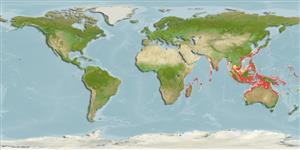>
Pleuronectiformes (Flatfishes) >
Bothidae (Lefteye flounders)
Etymology: Crossorhombus: Greek krossoi = tassel + Greek, rhombos = paralelogram (Ref. 45335).
More on author: Alcock.
Environment: milieu / climate zone / depth range / distribution range
Ecologia
marinhas demersal; intervalo de profundidade 13 - 60 m (Ref. 9824). Tropical
Indo-West Pacific: Bay of Bengal, northwestern Australia, South China Sea, China, Taiwan, Japan, Viet Nam, and Aru Islands, Indonesia.
Tamanho / Peso / Idade
Maturity: Lm ? range ? - ? cm
Max length : 18.0 cm TL macho/indeterminado; (Ref. 9824)
Raios dorsais (total) : 84 - 92; Raios anais : 63 - 74. Ground colour on eyed side brownish grey, with darker spots and blotches. Fins paler than body, dorsal and anal fins with small dark spots, caudal fin with 2 distinct dark bands. Males with small dark spots in anterior part of interorbital region. Blind side whitish in females. Males with distinct bluish black pyriform colour pattern on blind side. Body ovoid, its depth 1.7 to 2 times in SL. Head small, snout shorter than eye, profile steep anterior to interorbital area. Head length 3.3 to 4.5 times in SL. Interorbital region broad and concave, wider in males than females in specimens greater than about 6 cm SL. Males with a rostral spine and 1 to 3 low bony bumps around orbits. Both eyes on left side of head, front margin of upper eye slightly behind front margin of lower eye. Both eyes in males larger than about 6 cm SL with a flap on posterior area. Mouth small, reaching to or slightly beyond anterior margin of lower eye, length of upper jaw 3.1 to 4.3 times in head length. Teeth in upper jaw biserial, teeth of outer row more widely spaced than teeth of inner row; teeth in lower jaw uniserial. Gill rakers short and pointed. Scales on eyed side with long ctenii. Pectoral fin on eyed side with 11 to 14 rays, its length 1.3 to 1.6 times in head length in both sexes. Pectoral fin on blind side with 9 to 12 rays (Ref 42535).
Lives on mud bottoms and feeds on bottom-living animals (Ref. 9824). Sexually dimorphic characters develop at about 6 cm SL (Ref. 9824).
Ciclo de vida ou comportamento de acasalamento
Maturities | Reprodução | Spawnings | Egg(s) | Fecundities | Larvas
Sainsbury, K.J., P.J. Kailola and G.G. Leyland, 1985. Continental shelf fishes of the northern and north-western Australia. An illustrated guide. CSIRO Division of Fisheries Research; Clouston & Hall and Peter Pownall Fisheries Information Service, Canberra, Australia. 375 p. (Ref. 3131)
Status na Lista Vermelha da UICN (Ref. 130435)
Ameaça para os humanos
Harmless
Uso pelos humanos
Pescarias: sem interesse
Ferramentas
Relatórios especiais
Baixar XML
Fontes da internet
Estimates based on models
Preferred temperature (Ref.
123201): 23.6 - 28.8, mean 27.2 °C (based on 460 cells).
Índice de diversidade filogenética (Ref.
82804): PD
50 = 0.5312 [Uniqueness, from 0.5 = low to 2.0 = high].
Bayesian length-weight: a=0.00912 (0.00408 - 0.02036), b=3.05 (2.87 - 3.23), in cm total length, based on LWR estimates for this (Sub)family-body shape (Ref.
93245).
Nível Trófico (Ref.
69278): 3.5 ±0.37 se; based on food items.
Resiliência (Ref.
120179): médio(a), tempo mínimo de duplicação da população 1,4 - 4,4 anos (Preliminary K or Fecundity.).
Fishing Vulnerability (Ref.
59153): Low vulnerability (10 of 100).
